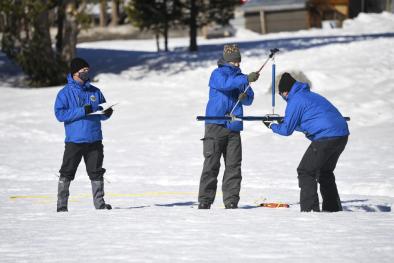Science Source
Twenty-First-Century Snowfall and Snowpack Changes over the Southern California Mountains
- Projects future snowfall and snowpack changes over the mountains of Southern California using a new hybrid dynamical–statistical framework
- Analyses variables pertaining to snow for the middle (2041–60) and end (2081–2100) of the twenty-first century under two representative concentration pathway (RCP) scenarios: RCP8.5 (business as usual) and RCP2.6 (mitigation)
- Compares these four sets of projections with a baseline reconstruction of climate from 1981 to 2000
- Finds that for both future time slices and scenarios, ensemble-mean total winter snowfall loss is widespread
- By 2041–60 under RCP8.5, ensemble-mean winter snowfall is about 70% of baseline
- By 2041–60 under RCP2.6, ensemble-mean winter snowfall is somewhat higher at about 80% of baseline
- By 2081–2100 under RCP8.5, winter snowfall is about 50% of baseline
- By 2081–2100 under RCP2.6, only a negligible further reduction from midcentury snowfall totals is seen
- States these figures are all associated with large intermodel uncertainty because of the spread in the GCM climate projections
- Assesses snowpack on the ground, as represented by 1 April snow water equivalent
- States the loss seen in snowpack is generally 50% greater than that seen in winter snowfall because of enhanced snowmelt
- Finds that by midcentury under RCP8.5, warming-accelerated spring snowmelt leads to snow-free dates that are about 1–3 weeks earlier than in the baseline period
Related Content
Headline

Feb 2, 2022 | AP
Dry January means less water than normal in California snow
Headline

Jan 25, 2022 | Climate Nexus Hot News
Air Pollution, Lack Of Snow, Hang Over Winter Olympics
Headline

Dec 21, 2021 | High Country News
Winter without snow is coming
Science Source
| Proceedings of the National Academy of Sciences
Global snow drought hot spots and characteristics
Huning and AghaKouchak


